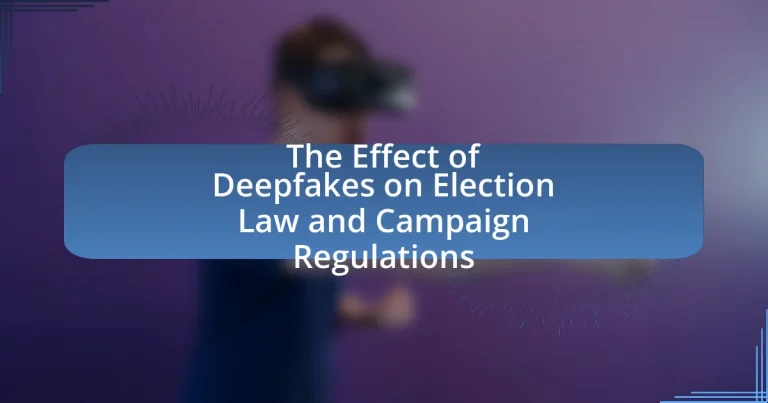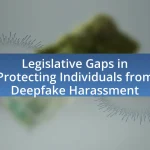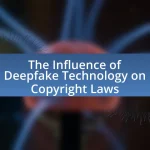Deepfakes are synthetic media generated by artificial intelligence that can distort audio and video content, posing significant challenges to election law and campaign regulations. This article examines the creation and use of deepfakes in political contexts, highlighting their potential to spread misinformation, manipulate voter perception, and undermine trust in democratic processes. It discusses the legal implications of deepfakes, current election laws addressing their use, and the ethical considerations surrounding misinformation in politics. Additionally, the article explores proposed measures to combat deepfakes, the role of technology in detection, and strategies for candidates and voters to navigate the risks associated with this emerging threat.
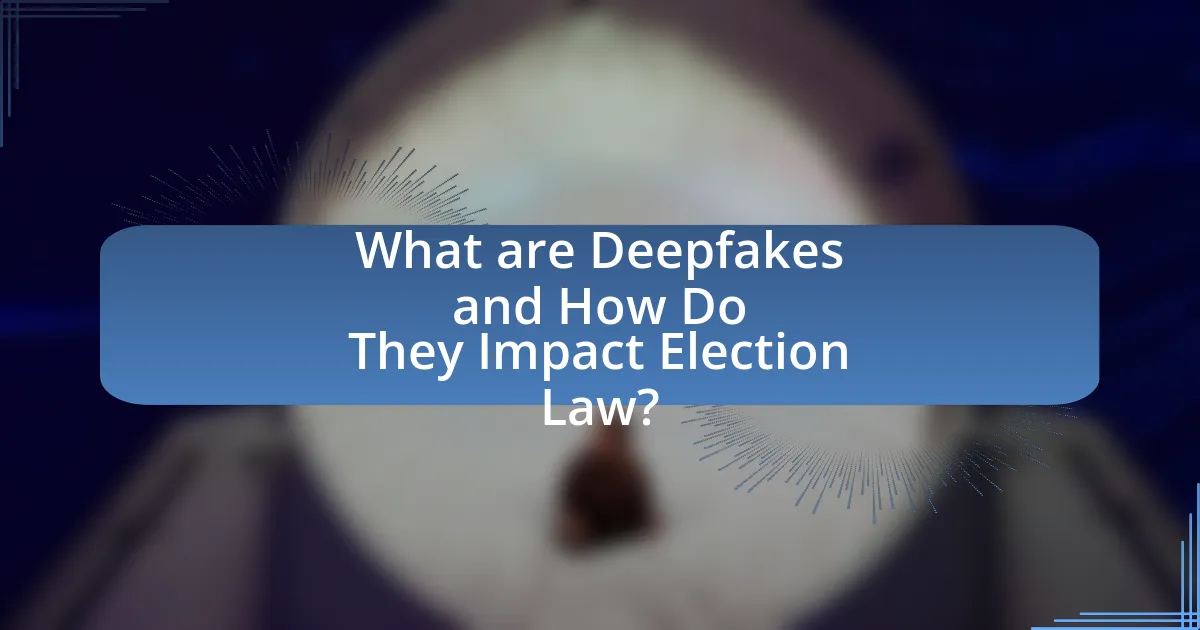
What are Deepfakes and How Do They Impact Election Law?
Deepfakes are synthetic media created using artificial intelligence that can manipulate audio and video to produce realistic but fabricated content. Their impact on election law is significant, as they can be used to spread misinformation, undermine trust in candidates, and influence voter behavior. For instance, deepfakes can create false narratives about political figures, potentially violating laws against election fraud and misinformation. The 2020 U.S. elections highlighted concerns about deepfakes, prompting lawmakers to consider regulations to address the dissemination of such content, as evidenced by discussions in the Senate regarding the need for updated legal frameworks to combat digital misinformation.
How are Deepfakes Created and Used in Political Campaigns?
Deepfakes are created using artificial intelligence techniques, particularly deep learning algorithms, which analyze and synthesize audio and visual data to produce realistic but fabricated content. In political campaigns, deepfakes are often used to manipulate public perception by creating misleading videos of candidates, making them appear to say or do things they never did, thereby influencing voter opinions and potentially swaying election outcomes. For instance, a study by the University of California, Berkeley, found that deepfake videos can significantly alter viewers’ perceptions of a candidate’s credibility and trustworthiness, highlighting the potential for deepfakes to disrupt democratic processes.
What technologies are involved in the creation of Deepfakes?
The technologies involved in the creation of Deepfakes primarily include Generative Adversarial Networks (GANs), deep learning algorithms, and computer vision techniques. GANs consist of two neural networks, a generator and a discriminator, that work together to produce realistic synthetic media by learning from large datasets of images and videos. Deep learning algorithms, particularly convolutional neural networks (CNNs), are utilized to analyze and manipulate visual data, enabling the synthesis of high-quality images and videos. Additionally, computer vision techniques facilitate the detection and tracking of facial features, enhancing the realism of the generated content. These technologies collectively enable the creation of convincing Deepfakes, which can significantly impact public perception and trust, especially in contexts like elections.
How do Deepfakes influence voter perception and behavior?
Deepfakes significantly influence voter perception and behavior by creating misleading representations of candidates, which can alter public opinion and trust. Research indicates that exposure to deepfake videos can lead to increased skepticism about the authenticity of political content, thereby affecting how voters evaluate candidates. For instance, a study published in the journal “Political Communication” found that voters exposed to manipulated videos were more likely to question the credibility of the candidates depicted, impacting their voting decisions. This manipulation can lead to misinformation spreading rapidly, ultimately shaping electoral outcomes and undermining democratic processes.
What Legal Challenges Do Deepfakes Present in Elections?
Deepfakes present significant legal challenges in elections primarily due to their potential to mislead voters and manipulate public opinion. The use of deepfake technology can result in the dissemination of false information, which may violate election laws that prohibit false statements about candidates. For instance, deepfakes can create fabricated videos that portray candidates making statements they never made, thereby infringing on laws related to defamation and misinformation. Additionally, the rapid spread of deepfakes through social media complicates the enforcement of existing regulations, as the origin and authenticity of content can be difficult to trace. Legal frameworks are often ill-equipped to address the unique challenges posed by deepfakes, leading to calls for new legislation specifically targeting this technology in the context of electoral integrity.
How do current election laws address the issue of Deepfakes?
Current election laws address the issue of deepfakes primarily through regulations that prohibit false statements and deceptive practices in political advertising. For instance, the Federal Election Commission (FEC) has guidelines that require transparency in political communications, which can be applied to deepfake content. Additionally, some states have enacted laws specifically targeting the use of manipulated media in elections, such as California’s law that makes it illegal to use deepfakes to harm or deceive voters. These legal frameworks aim to protect the integrity of the electoral process by holding individuals and organizations accountable for the dissemination of misleading information.
What are the potential legal repercussions for using Deepfakes in campaigns?
The potential legal repercussions for using Deepfakes in campaigns include violations of election laws, defamation claims, and potential criminal charges. Election laws in various jurisdictions prohibit misleading or deceptive practices that could influence voters, and Deepfakes can easily fall into this category by misrepresenting candidates or their positions. For instance, the Federal Election Commission (FEC) has guidelines that could classify the use of Deepfakes as illegal campaign contributions if they are deemed to mislead voters. Additionally, individuals or entities that create or distribute Deepfakes may face defamation lawsuits if the content harms the reputation of a candidate or misrepresents their actions. In some cases, the use of Deepfakes could also lead to criminal charges under laws addressing fraud or election interference, as seen in recent legislative proposals aimed at regulating synthetic media in political contexts.
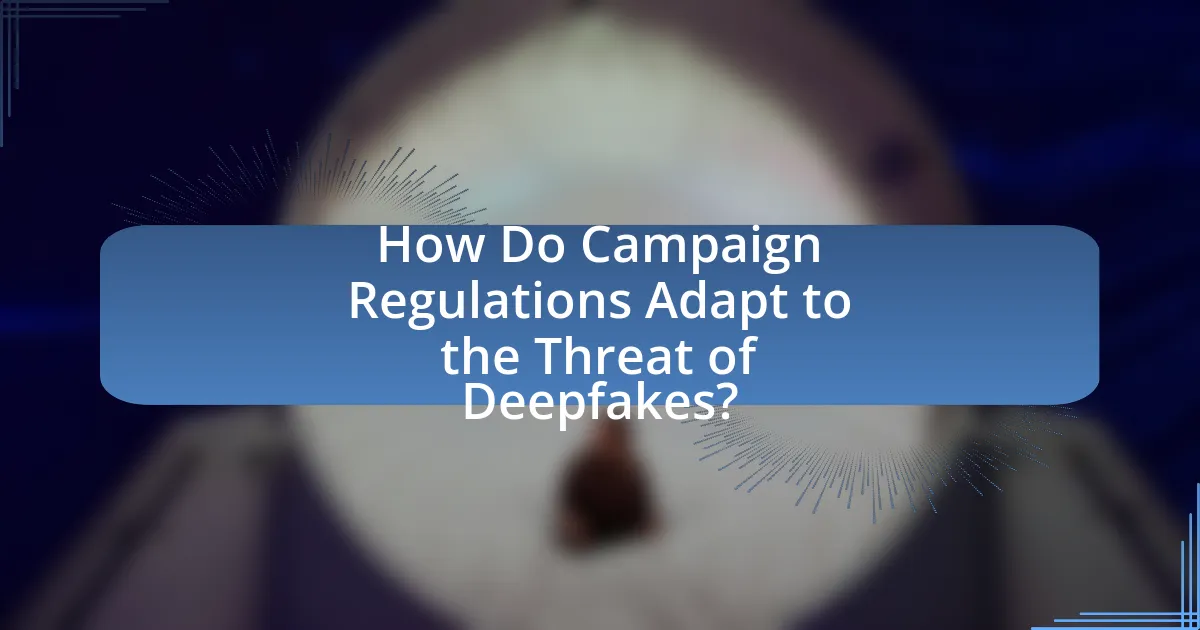
How Do Campaign Regulations Adapt to the Threat of Deepfakes?
Campaign regulations adapt to the threat of deepfakes by implementing stricter disclosure requirements and enhancing monitoring mechanisms for digital content. Regulatory bodies, such as the Federal Election Commission in the United States, have begun to address the potential for deepfakes to mislead voters by proposing rules that mandate transparency about the origins of political advertisements and the authenticity of video content. For instance, the introduction of laws that require platforms to label manipulated media can help mitigate the impact of deepfakes on public perception. Additionally, some jurisdictions are exploring penalties for the dissemination of deceptive deepfake content, reinforcing the legal framework surrounding election integrity. These adaptations are crucial as deepfakes can significantly influence voter behavior and undermine trust in democratic processes.
What Measures Are Being Proposed to Combat Deepfakes in Elections?
Proposed measures to combat deepfakes in elections include the implementation of stricter regulations on digital content, the establishment of verification technologies, and the promotion of public awareness campaigns. Stricter regulations aim to hold platforms accountable for the dissemination of manipulated media, while verification technologies, such as AI-based detection tools, are being developed to identify deepfakes effectively. Public awareness campaigns are designed to educate voters about the existence and potential impact of deepfakes, thereby fostering critical media literacy. These measures are essential as deepfakes can significantly undermine the integrity of electoral processes, as evidenced by instances where manipulated videos have misled voters during recent elections.
How can technology be leveraged to detect Deepfakes?
Technology can be leveraged to detect Deepfakes through the use of advanced algorithms and machine learning techniques. These technologies analyze inconsistencies in video and audio data, such as unnatural facial movements, irregular blinking patterns, and mismatched lip-syncing. For instance, a study by the University of California, Berkeley, demonstrated that deep learning models could achieve over 90% accuracy in identifying manipulated videos by examining pixel-level anomalies. Additionally, tools like Microsoft’s Video Authenticator and Deepware Scanner utilize AI to assess the authenticity of media content, providing real-time detection capabilities.
What role do social media platforms play in regulating Deepfakes?
Social media platforms play a crucial role in regulating deepfakes by implementing policies and technologies aimed at identifying and mitigating the spread of manipulated content. These platforms, such as Facebook, Twitter, and YouTube, have developed detection algorithms and community guidelines that prohibit the sharing of deceptive media, particularly during election periods. For instance, Facebook has partnered with third-party fact-checkers to review and label deepfake content, while YouTube has introduced features to flag potentially misleading videos. These measures are essential in maintaining the integrity of information shared on their networks, especially given that deepfakes can significantly influence public opinion and electoral outcomes.
What Ethical Considerations Arise from the Use of Deepfakes in Politics?
The ethical considerations arising from the use of deepfakes in politics include misinformation, manipulation of public perception, and erosion of trust in media. Misinformation occurs when deepfakes are used to create false narratives about political candidates, potentially influencing voter behavior based on fabricated content. Manipulation of public perception is evident when deepfakes distort reality, leading audiences to question the authenticity of legitimate political discourse. Furthermore, the erosion of trust in media is a significant concern, as the prevalence of deepfakes can cause skepticism towards all media sources, undermining democratic processes. These ethical issues highlight the need for regulatory frameworks to address the implications of deepfakes in political contexts.
How do Deepfakes challenge the integrity of political discourse?
Deepfakes challenge the integrity of political discourse by creating highly realistic but fabricated audio and video content that can mislead voters and distort public perception. This technology enables the manipulation of political figures’ words and actions, undermining trust in authentic media and complicating the verification of information. For instance, a study by the University of California, Berkeley, found that deepfake videos can significantly influence viewers’ beliefs, even when they are aware of the potential for manipulation. This erosion of trust in media sources can lead to increased polarization and misinformation, ultimately threatening democratic processes and informed decision-making in elections.
What responsibilities do candidates have regarding misinformation?
Candidates have the responsibility to actively combat misinformation during their campaigns. This includes verifying the accuracy of the information they share, correcting false statements made about themselves or their opponents, and promoting transparency in their communications. Research indicates that misinformation can significantly influence voter perceptions and decisions, as seen in studies conducted by the Pew Research Center, which found that 64% of Americans believe fabricated news stories cause confusion about the basic facts of current events. Therefore, candidates must implement strategies to ensure their messaging is truthful and to address misinformation promptly to maintain the integrity of the electoral process.
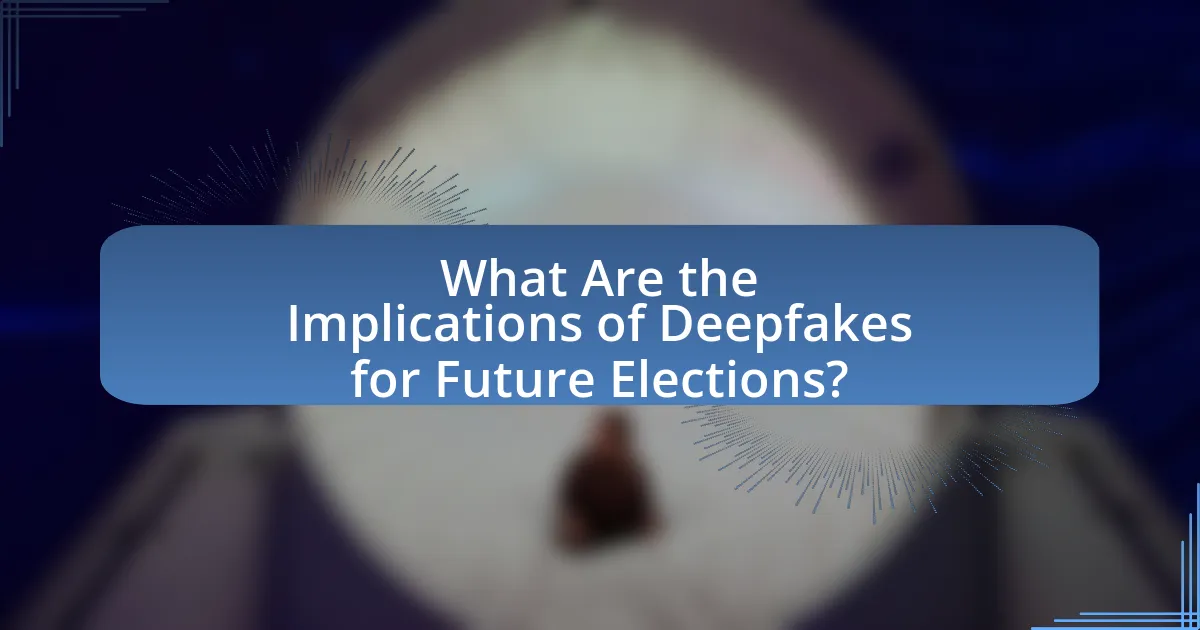
What Are the Implications of Deepfakes for Future Elections?
Deepfakes pose significant implications for future elections by undermining trust in political discourse and complicating the regulatory landscape. The ability to create realistic but fabricated videos can lead to misinformation campaigns that misrepresent candidates or manipulate public perception, as evidenced by incidents during the 2020 U.S. presidential election where deepfake technology was used to create misleading content. This erosion of trust can result in voter apathy and skepticism towards legitimate media sources, ultimately affecting voter turnout and engagement. Furthermore, existing election laws may struggle to address the rapid evolution of deepfake technology, necessitating new regulations to combat misinformation and protect electoral integrity.
How Might Deepfakes Change the Landscape of Political Campaigning?
Deepfakes could significantly alter the landscape of political campaigning by enabling the creation of highly realistic but misleading videos that can distort candidates’ messages or actions. This technology allows for the manipulation of audiovisual content, making it easier to spread disinformation and potentially influence voter perceptions. For instance, a study by the University of California, Berkeley, found that deepfake videos can lead to a 20% increase in the likelihood of viewers believing false information about political figures. As a result, the integrity of political discourse may be compromised, prompting calls for stricter regulations and legal frameworks to address the challenges posed by deepfakes in election contexts.
What strategies can candidates employ to mitigate the impact of Deepfakes?
Candidates can mitigate the impact of Deepfakes by employing strategies such as enhancing media literacy among their supporters and utilizing advanced detection technologies. By educating their audience on how to identify manipulated content, candidates can reduce the likelihood of misinformation spreading. Additionally, leveraging AI-based tools that can detect Deepfakes helps in quickly identifying and countering false narratives. Research indicates that media literacy programs can significantly improve individuals’ ability to discern credible information from manipulated content, thereby reinforcing the integrity of the campaign.
How can voters be educated about the risks of Deepfakes?
Voters can be educated about the risks of Deepfakes through targeted awareness campaigns that utilize social media, public forums, and educational programs. These campaigns should focus on explaining what Deepfakes are, how they can be created, and the potential consequences of misinformation in the electoral process. Research indicates that misinformation can significantly influence voter behavior, as seen in studies like the one conducted by the Pew Research Center, which found that 64% of Americans believe fabricated news stories cause confusion about basic facts. By providing clear examples of Deepfake incidents and their impacts on public perception, voters can better understand the importance of verifying information before sharing or acting on it.
What Best Practices Should Campaigns Follow to Address Deepfake Risks?
Campaigns should implement a multi-faceted approach to address deepfake risks effectively. First, they must invest in advanced detection technologies that can identify manipulated media, as studies show that AI-based detection tools can significantly reduce the impact of deepfakes on public perception. Second, campaigns should establish clear communication strategies to inform the public about the potential for deepfakes, emphasizing media literacy to help voters discern authentic content from manipulated material. Third, legal frameworks should be developed or adapted to hold creators of malicious deepfakes accountable, as existing laws may not adequately address the nuances of digital misinformation. Finally, collaboration with social media platforms is essential to ensure rapid response mechanisms are in place for reporting and removing harmful deepfake content, as timely action can mitigate the spread of misinformation.
How can campaigns effectively communicate their authenticity to voters?
Campaigns can effectively communicate their authenticity to voters by consistently sharing transparent and verifiable information about their policies, candidates, and campaign activities. This approach builds trust, as studies show that voters are more likely to support candidates who provide clear, factual details about their positions and actions. For instance, a 2020 survey by the Pew Research Center found that 70% of voters consider transparency in campaign communications crucial for determining a candidate’s trustworthiness. By utilizing social media platforms to engage directly with constituents and respond to inquiries in real-time, campaigns can further enhance their perceived authenticity.
What tools are available for campaigns to monitor and respond to Deepfakes?
Campaigns can utilize several tools to monitor and respond to deepfakes, including deepfake detection software, social media monitoring platforms, and fact-checking services. Deepfake detection software, such as Sensity AI and Deepware Scanner, analyzes video and audio content for signs of manipulation, providing campaigns with the ability to identify altered media quickly. Social media monitoring platforms like Brandwatch and Hootsuite allow campaigns to track mentions and shares of potential deepfake content across various channels, enabling timely responses. Additionally, fact-checking services, such as Snopes and FactCheck.org, assist campaigns in verifying the authenticity of information and media, helping to counter misinformation effectively. These tools collectively enhance a campaign’s ability to safeguard its integrity in the face of deepfake threats.
